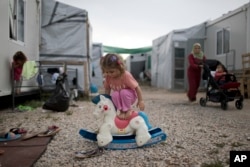The UN children’s fund is urging countries to do more to ensure the safety and wellbeing of tens of millions of children on the move.
The UN children’s fund (UNICEF) reports some 50 million children worldwide are on the move. It says many young people are moving safely with their families who are voluntarily migrating in search of a better life. However, for millions of others, it says the move is neither voluntary nor safe.
For example, UNICEF notes conflict has forced about 28 million children to flee their homes at great risk to their lives. In many cases, it says refugees have to use the services of smugglers and traffickers in hopes of reaching safety.
In this regard, UNICEF spokeswoman, Sarah Crowe, says 2017 has been a pretty horrendous year.
“We have seen some 400 children, estimated 400 children who have drowned trying to make their way to Europe," Crowe said. "We have seen an estimated 32,000 children who are currently in detention in the hands of smugglers and traffickeers in Libya. Of those, 11,000 are unaccompanied. We have seen children, unaccompanied children crossing mountain passes in the winter. We have seen them stuck on islands.”
Crowe says children on the move face deportation, drowning and detention. She says thousands are abused, exploited and enslaved during their perilous journeys. But, she says, it does not have to be this way.
She says nations should look for safe and legal pathways for migrants, such as granting humanitarian and school visas. She cites other positive measures that can be taken to protect and care for migrant children.
These include the promotion of community-based alternatives to detention, opening schools and health centers to migrant children, and ensuring access to justice and housing without fear of deportation.









